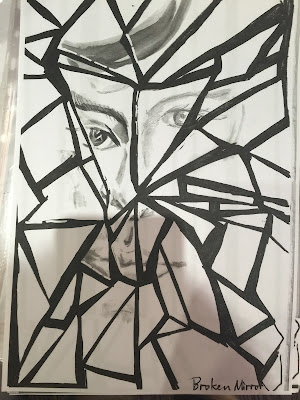Kinetic Narrative Workshop
Alexander Calder film by Roger
Sherman
Actions can be broken down into
elements, just like what we can do with our languages. Elements of moving are metaphors.
They can tell stories as languages do.
Alexander Calder changed the nature of
sculpture. He showed what sculpture could really be. The movements of his
sculptures were the core essence of those sculptures instead of their still
shapes.
In the workshop we were asked to just enjoy
the movement in those clips and listen to the sounds. Those sounds and rhymes
were tranches of the movements as well. And then we were asked to analyze, interrogate and draw the
movement. (Draw the MOVEMENTS itself instead of the STILL SHAPES)
I drew this one without looking at my
pencil. I realized that I was not drawing the shapes of the sculptures but the
movements. My hands were moving, turning, quivering simultaneously with the
sculptures.
Nabo
Gaum’s Manifesto
Space and time are reborn to us today.
The
Way Things to Go
Time is abstract and movement is concrete.
Sequential movements construct time. Concrete movements map time. Time is the
metaphors of concrete movements. Movements shape our cognitive structure and
understandings towards time. Meanwhile the time shape the movements.
Toy
Workshop
This showed us how movements can be played
and used as a narrative. We could mechanical toys like optical, acoustic,
gravity, balanced and etc. stuffs.
(Look
at Spooner’s moving animals by Paul Spooner)
Pictures could be reconstructed with
fragmental pieces of images into new ones. New stories~
The magic
waterfall has the same potential to tell two
stories on two different sides.
Movements: Chicken pecking, clown climbing, etc..
Puppets
Electro
cared kit…
Magnet…
My
WORK TODAY
A little boy sitting on the floor~
At the very beginning I just wanted to make
a little child that could be placed into any gesture so I made his legs and
hands using light clays with slipknots. Done with the body part, one idea came
to me. What I was focusing on was the exploration of the space so I made an
empty space as his head, and filled it with blocks just like we filled our
space with our stuffs used in life and constructed ourselves through learning
(through playing with toys). Then I drew a face on the back side of the space
to make it a metaphor for weak self growing into continuity of self, a face, a
facet to face the outside world. I kept the blocks blank to help with the
further exploration of narratives. I have got 8 blocks here, each having 6 façade,
which meant I could have 6 *8/4 carpets to draw stories on. And the blocks
could be put in different orders, positions, built up into different shapes
etc. I was playing with toys like lego and exploring the space like the child.






I took this for a great potential for my
narratives at the next stage.
Magnet could be a good material to make
stuff to move.













































